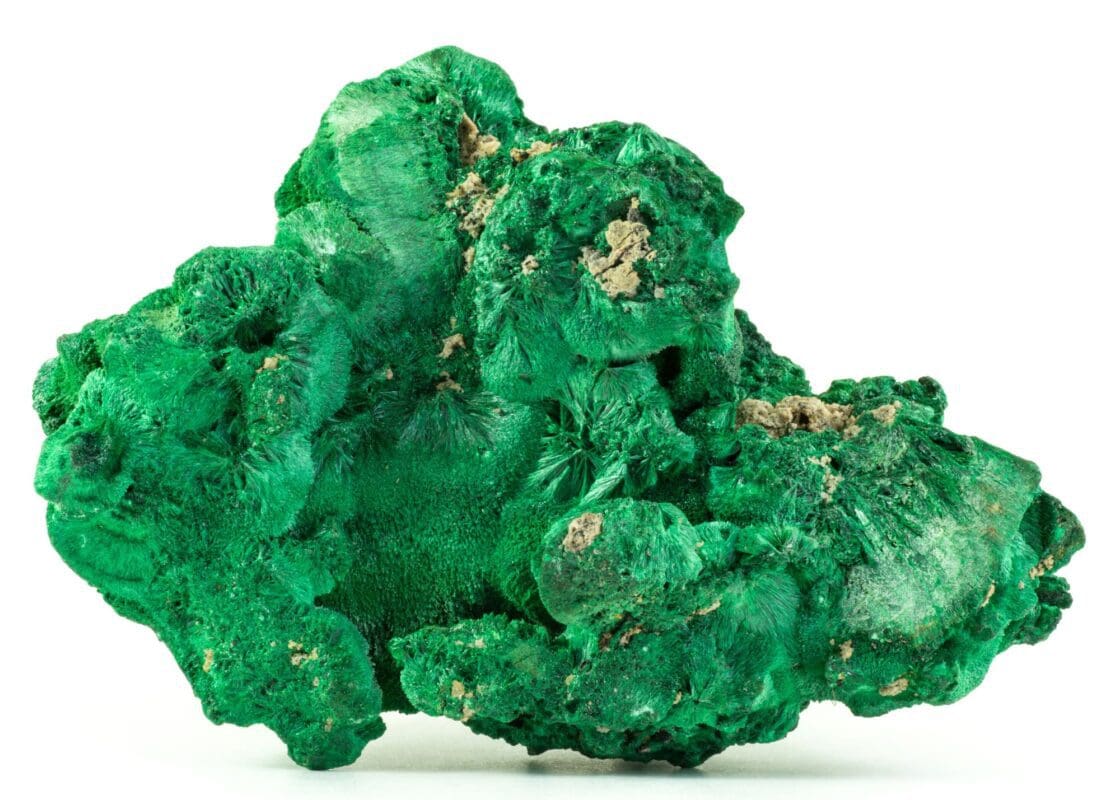Malachite: A Collector’s Jewel of History and Vibrance
Introduction
Did you know that Malachite has been used as a pigment for green paints since antiquity, once gracing the walls of Egyptian tombs and European palaces alike? This historical gemstone, with its rich, emerald-like green swirls and bands, has captivated humanity for thousands of years. In this article, we delve into the enchanting world of Malachite, exploring its unique beauty and profound historical significance.
Historical Significance
Malachite’s Historical Discovery and Usage: Malachite has a storied past, dating back to ancient Egypt where it was mined in the Sinai Peninsula. Its use was not just confined to ornamentation; ancient Egyptians also ground it into powder for eye shadow. The Romans used Malachite for architectural decoration, and in the Middle Ages, it was believed to protect against the evil eye and witchcraft.
Associations with Historical Figures or Events: Malachite has been favored by royalty and artists throughout history. Russian tsars used it extensively in their palaces, most notably in the Malachite Room of the Winter Palace. The stone’s presence in these historical contexts highlights its enduring appeal and status.
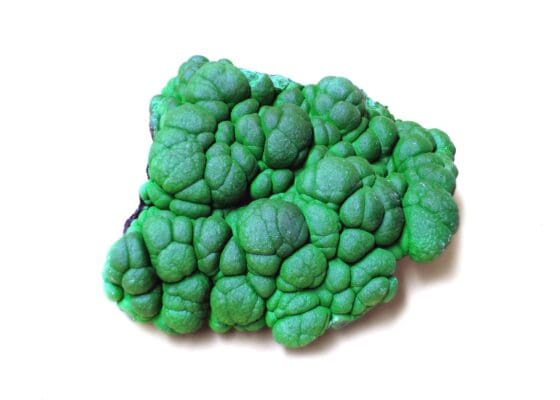
Geological Formation and Properties
Formation Process of Malachite: Malachite is formed through the weathering and oxidation of copper ores. This process, which can take thousands of years, results in the distinctive green coloration of Malachite, attributed to its copper content.
Physical and Chemical Properties: Known for its intense green color and unique banding patterns, Malachite is a copper carbonate hydroxide mineral. It typically forms in botryoidal (globular) masses with concentric banding that is either straight or swirled, creating captivating natural patterns. Malachite is relatively soft, scoring around 3.5 to 4 on the Mohs hardness scale.

Rarity, Collector’s Perspective, and Identifying Fakes
Rarity and Value to Collectors: Malachite, with its distinctive green color and unique banding, holds a special place in the hearts of collectors. While not as rare as some gemstones, high-quality Malachite with deep, vibrant green colors and intricate patterns can be quite valuable. Large specimens with exceptional clarity and unique formations are particularly sought after.
Availability for Purchase: For those interested in adding Malachite to their collection, our website offers a curated selection of Malachite pieces. Our collection ranges from raw stones and polished specimens to finely crafted jewelry, catering to a variety of tastes and preferences.
Distinguishing Genuine Malachite: To identify authentic Malachite, look for its characteristic bright green color and banding patterns. Imitations, often made of plastic or resin, usually lack the cold feel and heaviness of real stone. The unique concentric or swirling banding pattern of Malachite is difficult to replicate accurately in fakes.
Common Treatments: While Malachite is generally not subjected to heat treatment, it may occasionally be enhanced with waxes or oils to improve its luster. It’s important to be aware of these treatments, as they can affect the care and maintenance of the stone.
Value
Current Market Value Analysis: The market value of Malachite depends on several factors, including color intensity, pattern clarity, size, and overall aesthetics. High-quality specimens with rare patterns or large, polished pieces are typically more valuable.
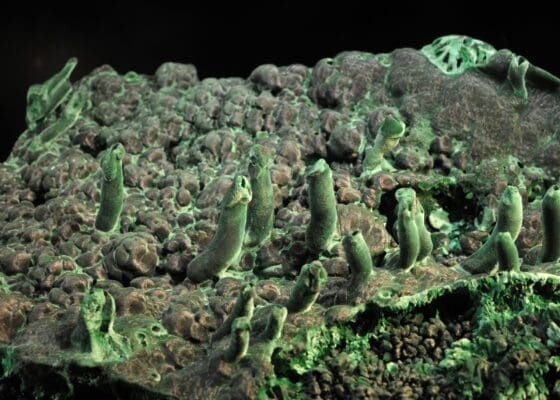
Factors Influencing Price: Rarity of the specimen, demand in the market, and overall condition contribute to the price of Malachite. Pieces that are part of historical artifacts or have been crafted into fine jewelry may also carry additional value.
Major Locations and Mining
Primary Locations: Major sources of Malachite include the Democratic Republic of Congo, Russia, Australia, and the United States (specifically Arizona). Each of these locations is known for producing Malachite with distinct characteristics.
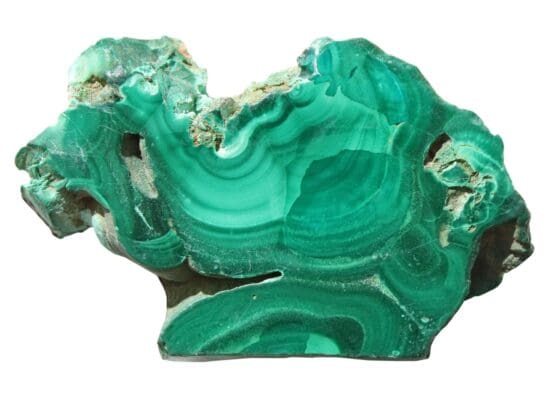
Public Gem Mining Information: While Malachite is predominantly mined commercially, there are locations where enthusiasts can mine for Malachite and other minerals. These public mining sites often provide an opportunity to find smaller specimens and enjoy a hands-on experience in gemstone discovery.
Uses and Applications
Industrial Applications of Malachite: Malachite, primarily a copper ore, has played a significant role in the extraction of copper metal. Its industrial use has been pivotal in the production of copper for electrical wires, plumbing pipes, and various other applications. Beyond its role in copper extraction, Malachite is also used as a pigment for green paints, though this use has decreased with the advent of synthetic alternatives.
Unique Applications in Creative Arts: Malachite’s striking green color and unique patterns have made it a favorite material in the decorative arts. It is used in inlay work in furniture, small sculptures, and ornaments. Historically, it has been used in architecture, notably in the Malachite Room in the Hermitage Museum, St. Petersburg, Russia, which features large Malachite columns and vases.
Metaphysical Properties, Beliefs, and Birthstone Information
Metaphysical Beliefs and Uses: Malachite is believed to be a powerful metaphysical stone, often associated with protection, healing, and transformation. It is said to absorb negative energies and pollutants from the atmosphere and the body. In spiritual practices, Malachite is used to stimulate the heart and throat chakras, enhancing empathy, easing heartache, and improving communication.
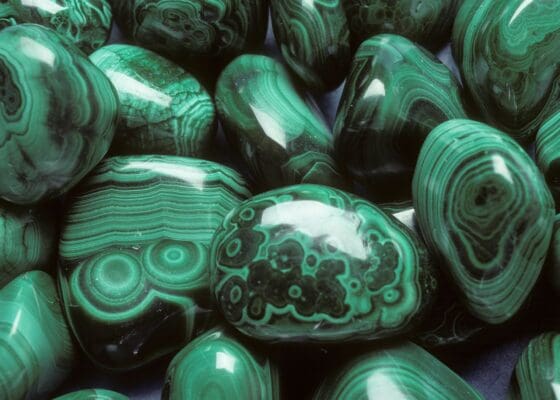
Association as a Birthstone: While not a traditional birthstone, Malachite is sometimes associated with the zodiac signs of Scorpio and Capricorn. It is believed to bring balance and abundance to those born under these signs.
The Rock/Mineral in Jewelry
Usage in Jewelry Making: Malachite is a popular choice for jewelry due to its vibrant color and unique banding. It is often cut into cabochons or beads and set in silver or gold. Due to its relative softness, it is usually used in pendants, earrings, and brooches, where wear and tear is minimal.
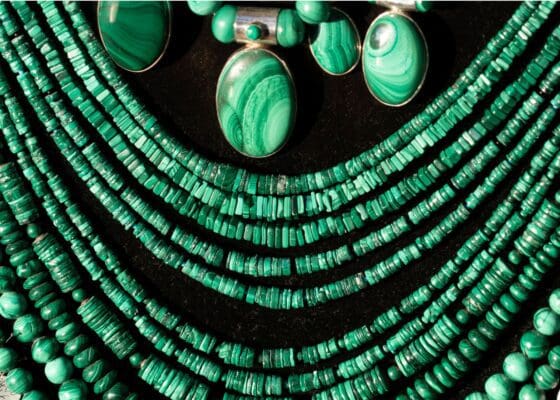
Popular Styles and Notable Jewelry Pieces: Malachite jewelry often features large, polished stones to showcase the stone’s natural beauty. It is frequently paired with other gemstones like diamonds or turquoise for contrast. Notable pieces include statement necklaces, elegant bracelets, and unique rings, often designed to highlight the stone’s natural patterns.
Fun Facts and Trivia about Malachite
- Historical Use as Eye Shadow: In ancient Egypt, Malachite was ground into powder and used as eye shadow.
- Russian Palaces: The Russian tsars were so fond of Malachite that they used it extensively in their palaces, notably in the Malachite Room in the Winter Palace.
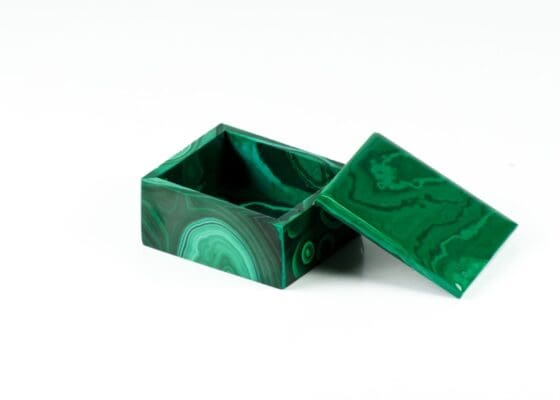
- No Two Alike: Each piece of Malachite is unique, with no two pieces having the same pattern, thanks to its natural formation process.
- A Painter’s Gem: Historically, Malachite was used as a pigment for green paint, prized for its vibrant hue.
Answers to Top Questions from Google’s ‘People Also Ask’
- What is Malachite good for?
Malachite is highly regarded for its strong protective properties. It is believed to shield against negative energies, environmental pollutants, and electromagnetic fields, making it a popular choice for those seeking a safeguard in their daily lives. Additionally, Malachite is often used in jewelry and ornamental objects, not only for its striking appearance but also for its perceived ability to promote emotional healing, transformation, and mental clarity. - What does Malachite mean spiritually?
In spiritual practices, Malachite is revered as a stone of transformation and healing. It’s associated with the heart chakra, believed to enhance emotional balance, open the heart to love, and facilitate deep emotional healing. Malachite is also thought to be a stone of empowerment, especially in understanding and expressing one’s deepest feelings and desires. It is often used in meditation to gain insight and enhance intuition. - Why is Malachite so toxic?
Malachite’s toxicity is due to its copper content. When raw Malachite is cut, drilled, or ground, it can produce fine dust particles that are toxic if inhaled or ingested. This is particularly a concern for lapidary artists and miners. Therefore, it is crucial to handle raw Malachite with care, use appropriate protective equipment when working with it, and ensure good ventilation in the workspace. - What does Malachite do when you wear it?
Wearing Malachite is believed to provide several benefits. It’s said to act as a guardian stone, absorbing negative energies and offering psychic protection. People also wear Malachite to enhance creativity, improve confidence, and encourage risk-taking. It’s thought to bring emotional balance, helping the wearer to overcome past traumas and to approach life changes with optimism and determination. - Who should not wear Malachite?
Due to its powerful energies, Malachite might be overwhelming for some individuals, especially those who are sensitive to crystal energies. Pregnant women and individuals with heart conditions are often advised to use Malachite cautiously, as its strong energy may affect these conditions. It’s always recommended to listen to one’s body and intuition when using Malachite. - Is it OK to sleep with Malachite?
- Sleeping with Malachite can be beneficial for those looking for emotional healing or spiritual protection during sleep. However, its intense energy might disrupt sleep for some people, particularly those who are sensitive to crystal energies. It’s advisable to start with short durations and assess how the body and mind react before making it a regular practice.
- What are the disadvantages of Malachite?
Besides its softness and vulnerability to scratches, Malachite also requires careful handling due to its copper content, especially in its raw form. Prolonged exposure to water, acids, and harsh cleaning chemicals can damage the stone. Additionally, as a powerful stone, it may have overwhelming energy for some individuals. - How do you activate Malachite?
Activating Malachite involves setting specific intentions for the stone’s use. Holding the stone in your hands and meditating on your intentions can help activate its energies. Cleansing the stone regularly using methods like moonlight exposure, smudging with sage, or placing it on a selenite plate can also help maintain and activate its energy. - Is it bad to touch Malachite?
Touching polished Malachite is generally safe and can be a pleasant sensory experience due to its smooth texture. However, caution should be exercised with raw Malachite, particularly when handling dust or small particles, to avoid potential copper toxicity. - Why can’t Malachite get wet?
Malachite’s porous nature makes it susceptible to water absorption, which can lead to changes in the stone’s appearance, such as loss of luster or color alterations. Exposure to water can also weaken the stone, making it more prone to scratches and damage. - Where is the best place to put Malachite?
Malachite is best placed in areas where its protective qualities can be maximized, such as living spaces, workplaces, or near electronic devices. It is also beneficial in spaces used for meditation or emotional healing, as it promotes a balanced and open heart chakra. - Why am I so attracted to Malachite?
The attraction to Malachite often stems from its mesmerizing appearance and the energy it exudes. People may be drawn to Malachite because they subconsciously seek the balancing, protective, and transformative energies that the stone is believed to provide. This attraction can also be a sign of an emotional or spiritual aspect within oneself that resonates with the properties of Malachite.

Malachite Quiz for Collectors and Enthusiasts
Test Your Knowledge of Malachite!
- Where was Malachite historically mined in ancient times?
A) Russia
B) Egypt
C) China - What unique physical property is Malachite known for?
A) Fluorescence
B) Unique banding patterns
C) Piezoelectric effect - Malachite is primarily composed of which metal’s carbonate?
A) Iron
B) Copper
C) Zinc - What is the Mohs hardness of Malachite?
A) 3.5 to 4
B) 5 to 6
C) 7 to 8 - In metaphysical beliefs, Malachite is associated with which chakra?
A) Root Chakra
B) Heart Chakra
C) Crown Chakra
Embark on a journey of discovery with this engaging quiz about Malachite, a gemstone beloved by collectors and geologists alike. Share your results and continue exploring the fascinating world of this vibrant green mineral!
Conclusion
As we conclude our exploration of Malachite, it’s clear that this vibrant green gemstone holds a unique place in both the realms of natural beauty and metaphysical practice. Renowned for its striking banding and rich color, Malachite has captivated collectors and artisans for centuries, finding its place in exquisite jewelry, ornamental carvings, and even in the realm of fine art. Beyond its physical allure, Malachite is equally cherished in holistic practices for its believed healing properties, offering protection, emotional balance, and spiritual growth.
For those drawn to the enchanting world of Malachite, whether as collectors, enthusiasts, or practitioners of holistic healing, our collection offers a diverse range of Malachite pieces. From polished stones and intricate jewelry to rare and unique specimens, discover the perfect piece of Malachite to add to your collection or healing practice. Visit our website to explore our selection and find a Malachite treasure that resonates with you.
Related Rocks and Minerals
- Azurite: Often found alongside Malachite, Azurite is known for its deep blue color, offering a striking contrast to Malachite’s green.
- Chrysocolla: This copper silicate mineral exhibits a vibrant blue-green hue and is sometimes found mixed with Malachite, creating stunning specimens.
- Cuprite: Known for its red coloration, Cuprite is another copper mineral that forms in similar environments to Malachite.
- Turquoise: Appreciated for its sky-blue to green color, Turquoise shares a color palette with Malachite and is often used in similar artistic and jewelry contexts.
- Lapis Lazuli: With its deep blue color and golden inclusions, Lapis Lazuli complements Malachite in jewelry and decorative arts.
References and Further Reading
- The Mineralogical Society of America: For detailed scientific information on Malachite’s properties and formation.
- Gemological Institute of America (GIA): Offers extensive resources on gemstones, including Malachite’s identification and care.
- Mindat.org: Provides comprehensive data on Malachite’s global occurrences and mining locations.
Answers to the Quiz:
- Answer: B) Egypt
- Answer: B) Unique banding patterns
- Answer: B) Copper
- Answer: A) 3.5 to 4
- Answer: B) Heart Chakra

